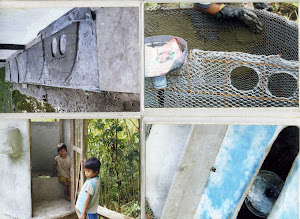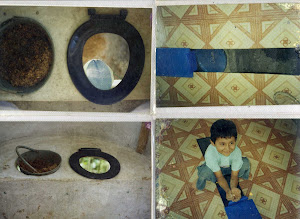






The Waterless Urinal of reused materials / El Urinario Sin Agua hecho de materiales reutilizados

Here we can see the shallow ditches for perforated urine hoses that were covered with sand.
Aquí observamos las zanjas donde las mangueras perforadas para la orina están cubiertas con arena.
(Scroll down for English)El 25 y 26 de mayo, 2011, llevamos al Inodoro Seco un gran paso adelante, en términos de construcción ágil, practicidad, reducción de la huella ambiental y aceptabilidad por parte de los usuarios. Construí con la empresa forestal ServiForest (
http://www.serviforest.com) un Inodoro dentro de la misma casa de la sede de su proyecto de reforestación en la cuenca del río Lelia, la que provee agua a la creciente ciudad de Santo Domingo de los Colorados, en el pie de montaña de la Costa del Ecuador. Además, lo adaptamos dentro de una casa ya construida... y con materiales de fácil acceso, muchos de los cuales reciclados.
Tiene los siguientes elementos:
- Una banca de madera (38cm de alto, 80 de ancho y unos 60 hacia atrás), cubierto con vinil para mayor elegancia y más fácil limpieza. Debajo del vinil, la madera está protegida con viejo aceite de motor ("quemado").
- Un asiento de inodoro normal de plástico.
- Un balde plástico de 20 litros invertido y atornillado a la parte inferior de la banca, para que sirva de ducto por donde caen las heces a su respectivo recipiente intercambiable (en este caso, un saco). La mayor parte de la base del balde fue cortado, junto con un costado que permite colocar el embudo para la orina.
- Una botella plástica de 4 litros que cumple la función de embudo para la orina, con dos "alas" de su parte cilíndrica que abrazan al balde y completan el contorno. Tiene una malla plástica verde para prevenir el ingreso de sólidos y esta malla está cosida con nailon de pesca en su parte curva entre las alas.
- Un tubo de PVC de 2 pulgadas, una botella desechable de PET de 3 litros (como reservorio temporal) y una manguera perforada de media pulgada (del tipo de usa para conecciones eléctricas ... y que es reciclada!) de 12 metros, para distribuir la orina entre árboles frutales. (La orina podría ir también directamente al compostaje o como fertilizante para los arbolitos en el vivero.)
- Un saco corriente tejida de polipropileno amarrado al balde, para recibir las heces, juntas con material seco que se agrega con cada uso (y antes del primer uso). Una piola aprieta muy sencillamente el filo del saco, ajustándolo al balde. Las ventajas del saco incluyen su bajo costo, su fácil acceso y su permeabilidad para gases como oxígeno y vapor de agua. Sin embargo, si los usuarios prefieren, pueden colocar otro balde de plástico dentro del saco.
- Tubos de ventilación pasiva, comenzando con dos tubos realizados con botellas desechables de plástico PET, de unos 1,1 litros (con una malla plástica donde están cosidas al balde con nailon de pesca y luego la unión cubierta con cinta adjesiva). Luego, se empata por medio de una botella plástica de 6 litros a un tubo de PVC de 16cm para pasar el filo del techo. El final del tubo fue cortado en un fuerte ángulo (bajando 32cm en un lado), para ampliar el hueco de salida y así crear mayor ventilación. De esta manera, la malla antimosco metálica en la punta queda vertical y ha de entrar muy poca lluvia (y puede salir por la tapa apenas aflojada de la botella de 6 litros).
También armamos un Urinario Sin Agua muy eficientemente con otra botella de 4 litros, fijada en el tubo de PVC de 2 pulgadas que pasa el piso y un pedazo de la misma botella grapada en la pared de madera con vinil. Los dos embudos, tanto del Inodoro como del Urinario, pueden ser retirados fácilmente para limpieza, mantenimiento y eventual reemplazo.
Las mayores inversiones de petroleo nuevo fueron para el tubo de ventilación, el vinil y el asiento. Este tubo podrá tal vez ser realizado de una serie de botellas de 6 litros cortadas. Sin embargo, el vinil y el asiento convencional se justifican, ya que contribuyen mucho
la aceptabilidad por parte de los usuarios.
Las ventajas de este modelo incluyen:
- El saco está siempre en justo el lugar correcto.
- El borde del saco, que luego se va a amarrar, permanece limpio.
- Fácil acceso para cambiar los sacos (utilizando un palo para ayudar a rodear el balde con el saco).
- El contorno del interfaz con el usuario está bien definido y fácil de limpiar.
- Amplia ventilación, a través de mallas.
- No hace falta construir una cámara hermética debajo del inodoro.
- No hay ninguna parte donde esconderse las criaturas no deseadas, ya que el interior del saco es visible desde arriba y el resto desde afuera de la casa.
Es un caso sumamente oportuno para Inodoros Ecológicos Secos, ya que es una zona donde se colecta el agua para la ciudad y, como están haciendo reforestación, hay necesidad para los fertilizantes. La primera tarde, expuse el concepto en una reunión del barrio y hubo verdadero interés.
Estamos organizando para construir más Inodoros con ServiForest.
Saludos, Chris- - -
A Dry Toilet of Bottles, a Bucket and a Sack (for ServiForest) May 25 and 26, 2011, we took UDDTs a big step forward, in terms of quick construction, practicality, reducing our environmental footprint, and acceptability by the users. The forestry company, ServiForest (http://www.serviforest.com), and I built a UDDT inside the house and office of their reforestation project in the Lelia River Watershed, which provides water to the growing city of Santo Domingo de los Colorados, at the western foot of the Andes in Ecuador. In addition, we adapted it within the already built house ... and with readily available materials, many of which were recycled. This UDDT has the following elements: - A wooden bench (38cm high, 80 wide and about 60 toward the back), covered with linoleum for more elegance and ease of cleaning. Under the linoleum, the wood is protected with post-consumer motor oil.
- A standard plastic toilet seat.
- A 20-litre plastic bucket, upside down and screwed onto the under side of the bench, to serve as a chute for the feces to fall through to their respective interchangeable receptacle (in this case, a sack). Most of the bottom of the bucket, together with one of its sides to make room for the urine funnel.
- A 4-liter plastic bottle cut to serve as a urine funnel, with two "wings" that embrace the bucket and complete the outline. It has a green plastic mesh to keep solids from going in, which was sewn into place along the curved section between the wings.
- A small section of 2-inch PVC pipe, a disposable 3-liter PET plastic bottle (as a momentary reservoir), and a 12-meter-long half-inch perforated hose, to distribute the urine among their fruit trees. (Urine could also go straight to the project's compost pile, or collected to be dosed as fertilizer to their tree seedlings.)
- A standard, woven, polypropylene sack, tied around the bucket, to receive the feces, plus the dry cover material that is added with each use (and before the first use). A string tightens the mouth of the sack. The advantages of the sack include low cost, easy access, and its permeability to gases, such as oxygen and water vapor. Nonetheless, if users prefer, they can place another bucket in the sack to receive the feces.
- Pipes for passive ventilation, starting with two pipes made from disposable PET bottles, of about 1.1 liters (with a plastic mesh where they are sewn to bucket with fishing line and then sealed with adjesive tape). Further on, these are joined via a 6-liter PET bottle to a 3-meter-long 16cm PVC pipe that reaches above the edge of the roof. The end of the pipe is cut in a sharp angle (32cm down on one side) to make the exit hole larger and thus creat more draft. In this way, the metallic fly screen on the end of the pipe is vertical and very little rain is likely to get in (and will be able to get out via the slightly loose lid on the 6-liter bottle).
We also made a Waterless Urinal very efficiently from another 4-liter plastic bottle, held in place by the 2-inch PVC pipe coming through the floor and a piece of the same bottle stapled to the plank wall covered in linoleum. Both of these funnels (the one in the toilet and the one in urinal) can be taken out for cleaning, maintenance, and eventual replacement. The biggest investments in new petroleum were the vent pipe, the linoleum, and the toilet seat. This pipe could potentially be made from a series of cut 6-liter bottles joined together (and possibly protected on the outside with a layer of paper and cement, as Peter Morgan has done). Nonetheless, the linoleum and the seat seem justified, as they contribute greatly to user acceptance.
Advantages of this model include:
- The sack is always in just the right place.
- The edge of the sack, which will later be tied shut, stays clean.
- Easy access for changing sacks (using a stick to help get the sack around the bucket).
- Well-defined, easy-to-clean perimeter of the user interface.
- Ample, screened ventilation.
- No need to try to build an air-tight chamber underneath.
- There is nowhere for unwanted creatures to hide out, since the interior of the sack is visible from above and everything else is visible from the outside of the house.
This is an especially appropriate case for building UDDTs, since this where the water is being collected for a whole city, plus they are doing reforestation and they can put the fertilizers to use. The first afternoon, I explained the idea in a neighorhood meeting and there seemed to be genuine interest. We are organizing to build more UDDTs with ServiForest. Best wishes, Chris



























